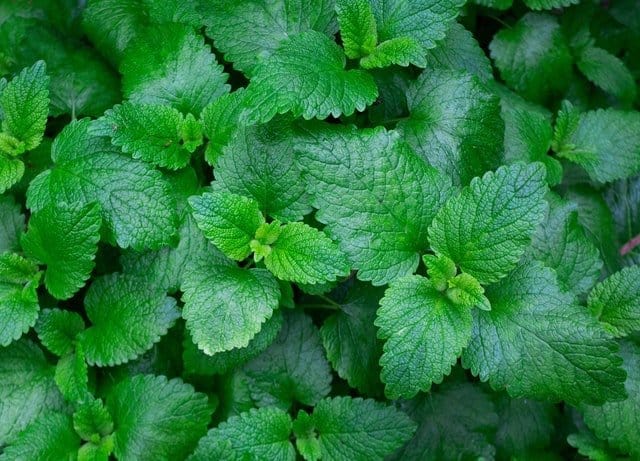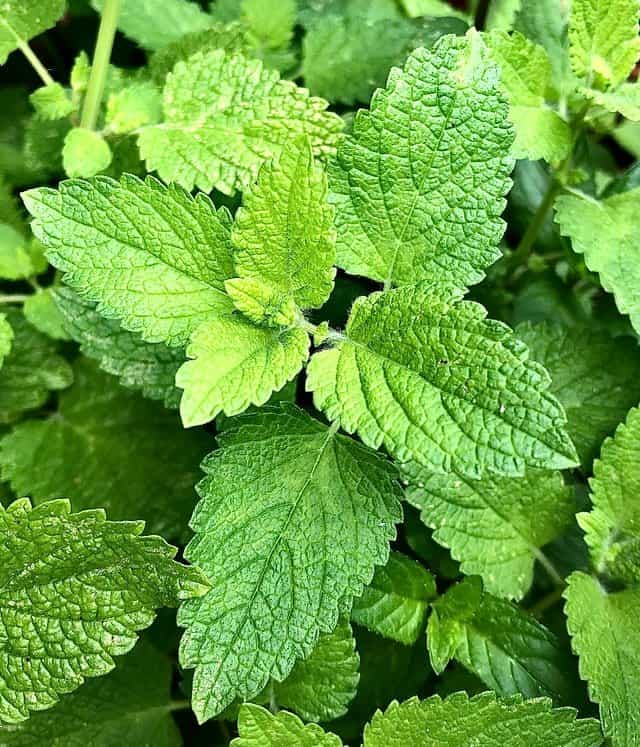How to grow mint in pots
Mint is a fragrant, delicious, multi-purpose herb that’s so easy to grow it can easily take over when planted in the ground. That’s why it’s perfect for a container herb garden! Once you know how to grow mint in pots, you’ll be able to produce as much as you need, while controlling spread.
One time we lived in a house where the previous owners grew mint and lemon balm in the front flower beds.
So guess what I inherited? TONS of mint and lemon balm. The stuff really does take over, when left to its own devices and unlimited space!
At one point some mint even managed to pop up around the mailbox, across the whole yard from that flower bed. How?? I still don’t know, but you have to admit the persistence is impressive.
This is exactly why mint does best in pots and containers (unless you’re trying to grow a huge mint crop and don’t mind the takeover, in which case, plant it wherever you want!).
With pots, you can control the spread while growing plenty for use in your kitchen and household.
All about mint
Mint plants are hardy and one of the easiest herbs to grow; they thrive in sunlight or partial shade.
Mint is great to use as a garnish and it tastes amazing with fish, meat, poultry, or vegetables. Mint also blends well with green or fruit salads. Mint can be used with vegetables including peas, new potatoes and carrots.
Mint has been around for thousands of years and there are records showing that people were using this herb back in ancient Egypt.
Did you know that there are also other ways to use mint besides the kitchen? Mint is also traditionally used in herbal remedies, and you can make natural cleaning products with peppermint oil too.
Read on for all the details about how to grow mint in pots! You and your flower beds will be glad you did.
This post may contain affiliate links. If you buy something through these links, we may earn a small commission at no cost to you.

How to grow mint in pots
Mint is a very easy plant to grow and makes a great addition to your patio herb garden. It spreads by sending out runners known as rhizomes and can become an invasive plant if you let it, which makes it perfect for containers because … it’s contained!
Growing mint involves very few special considerations. Mint is a versatile plant that prefers moist, nutrient rich soil and lots of sunlight. It’s a great container plant and thrives in a wide range of conditions.
That said … mint does not like extreme temperatures and will do best with similar environment conditions as many herbs: warm and moist, not too hot or cold.
Always use high quality potting mix, to ensure fertile soil and the right balance of organic matter like peat moss. My favorites are Miracle-Gro Potting Mix and Fox Farm Ocean Forest Potting Soil Mix.
Choose a container
Pots for mint should be 8-10 inches or more in diameter and 12 inches deep to accommodate the plant’s vigorous root system.
Mint can get tall (as much as 18″) and really does spread fast, so if you have a large pot or a big 10-gallon grow bag, go for it!
Mint containers should have drainage holes and can be any material. Just keep in mind terracotta and other unglazed clay pots will dry out faster than glazed or plastic ones.
Where to plant mint
You’ll want a sunny spot, although it can also tolerate partial shade. At least 6 hours of direct sunlight per day is ideal.
When to plant mint
Mint seedlings or transplants can be planted outside in containers in spring after last frost. You can also plant in late summer or fall for a fall harvest.
Mint is generally frost tolerant, but it will die back and go dormant in winter, except in zone 8 and farther south.
If you’re in a cooler climate and want to keep it going as a perennial, it’s a good idea to bring mint indoors for the winter months. Just keep it in a sunny window and water and harvest regularly.

How to grow mint from seed
You can start mint seeds indoors in early spring, about 6-8 weeks before your first frost date (check this frost date calendar if you’re not sure).
Use a soilless seed starting medium like coconut coir or Miracle-Gro seed-starting mix in a seed-starting tray. Those are the ones I use and highly recommend.
You can also start them outdoors 1-2 weeks after last frost, in the containers you plan to use for the season. Mint prefers temps above 68 degrees.
Mint seeds need sunlight to germinate, so plant them just 1/4″ deep. The best way to do this is to sprinkle them on the surface and then add a tiny thin layer of the soilless medium or potting soil. Pat gently to secure the seeds.
In a 12″ container, plant 4-6 mint seeds and thin to 1 once they’re a few inches tall. Remember … these will spread! One can easily fill a container.

Germination usually takes 1-2 weeks. While waiting for germination, and for several weeks after, keep them lightly watered. The soil should remain moist but not soggy.
I use a spray bottle to mist seeds and young seedlings.
After they’re a bit more established, maybe a few inches tall, you can gently water the ones in containers with a watering can.
Mint establishes strong roots quickly, so you probably won’t displace them with a watering can flow at that point.
Recommended mint seeds: Common mint, heirloom variety
Varieties of mint
There are many species of mint, each with their own flair — sometimes strong flavor, sometimes subtle, but always interesting and usually better than anything you can find in the grocery store.
No matter what type of mint you decide to grow, they’ll have essentially the same planting and care instructions. Always read the seed packet for details.
- Spearmint
- Apple mint
- Corsican mint
- Chocolate mint
- Lemon balm
- Peppermint
- Winter mint
- Fruit mint
- Ginger mint
- Orange mint

How to grow mint from cuttings
Mint is easy to propagate from cuttings, as its roots are strong and resilient. A cutting from a healthy plant will readily re-root itself.
There are two main ways to grow mint from cuttings: re-rooting in water or re-rooting in soil.
Either way you choose, start by using sharp scissors or garden shears to cut a stem about 6 to 8 inches long from the top of your plant. Cut just below a leaf node, the spot where leaves emerge.
Include at least two or more pairs of leaves above this point.
Strip off all leaves except those at the tip, leaving the leaf nodes intact along the stem.
Some people prefer to dip stems in rooting hormone to help them propagate, but mint does well from cuttings and doesn’t necessarily need it.
Potting soil rooting option
Insert cutting several inches deep in moist, but not soggy, potting soil and water well. Keep in a shady spot while the cutting re-roots and gets established.
After a week or two, you can prune a few leaves from the top to encourage growth.
Water rooting option
Take a cutting the way described above. Place the stem in a cup or other small container of water until you see roots grow and get stronger.
Then gently transplant into potting soil and water well. Keep the newly potted mint in the shade for a week or two while it gets established, then harden off by giving it a little more sun each day, until it’s in the sun full time.

Watering instructions
Mint likes moist soil but doesn’t like excess water or soggy roots. When the top 1/2″-1″ of potting soil is dry, it’s time to water!
Keep an eye on it throughout the growing season and water your mint frequently to maintain its moisture level, daily during hot spells.
Fertilizer instructions
Mint is a heavy foliage producer and should be fertilized during active growth, usually in spring and summer.
Start by including some time-release fertilizer pellets in the potting soil when you plant your mint. I use and highly recommend Jobe’s Organic Slow-Release Fertilizer. Super easy and lasts for a couple of months.
Then fertilize again after it produces new shoots, usually around 6-8 inches tall.
A balanced fertilizer will work well for mint, or something with higher nitrogen to encourage leaf growth. I recommend fish emulsion or organic bone meal. Be sure to dilute per package instructions.

Pests and diseases
Powdery mildew is one common problem that can affect mint if the surrounding air is humid or damp. If this occurs, use baking soda spray to address it. Although baking soda is considered safe for most plants, test it on a small portion of mint before applying to the whole plant.
When to harvest mint
Mint is really easy to harvest: just pick some fresh leaves anytime! You’ll get the best flavor before the plant flowers and goes to seed, so pick before then and pinch off flowers when they appear.
You can harvest the leaves for use or cuttings at any time of year by cutting them back when needed–just make sure not to cut back more than 1/3 of the plant at a time.
Uses for mint
- Fresh mint chip ice cream
- Homemade herbal tea
- Fresh mint tea
- Herbal remedies
- Savory dishes like tabbouleh
Planning to grow herbs in pots on your deck? These articles can help round out your container herb garden:
- How to grow basil in a pot
- Growing rosemary in containers
- How to grow thyme in a pot
- How to grow catnip in a pot
- Growing chamomile in pots
- How to dry herbs
- Unusual home remedies for plants







I live in Michigan. I planted Sweet Mint and Hummingbird Mint in containers this year. My question is about winter…if I bring them indoors will they survive with only a bright window for light, no direct sunlight? Or would it be better to leave them outdoors, covered and put in the deck close to the house where they’re protected by the awning? Thx in advance for any insight you can provide. Peace- Oam
Hi Pam! Mint is frost hardy and generally does fine overwintering outdoors. It will die back and re-emerge in spring. It helps to add a few inches of mulch to the soil to help insulate the roots. Since you’re so far north, it’s probably a good idea to put the container in a protected spot and/or use some kind of protective cover, like row cover material or horticultural fleece. That said … you could also bring it inside, especially if you’d like to continue harvesting a bit during the off-season. Mint does well indoors and a bright window should be fine. So it’s really up to you! Thanks for visiting Patio Garden Life!